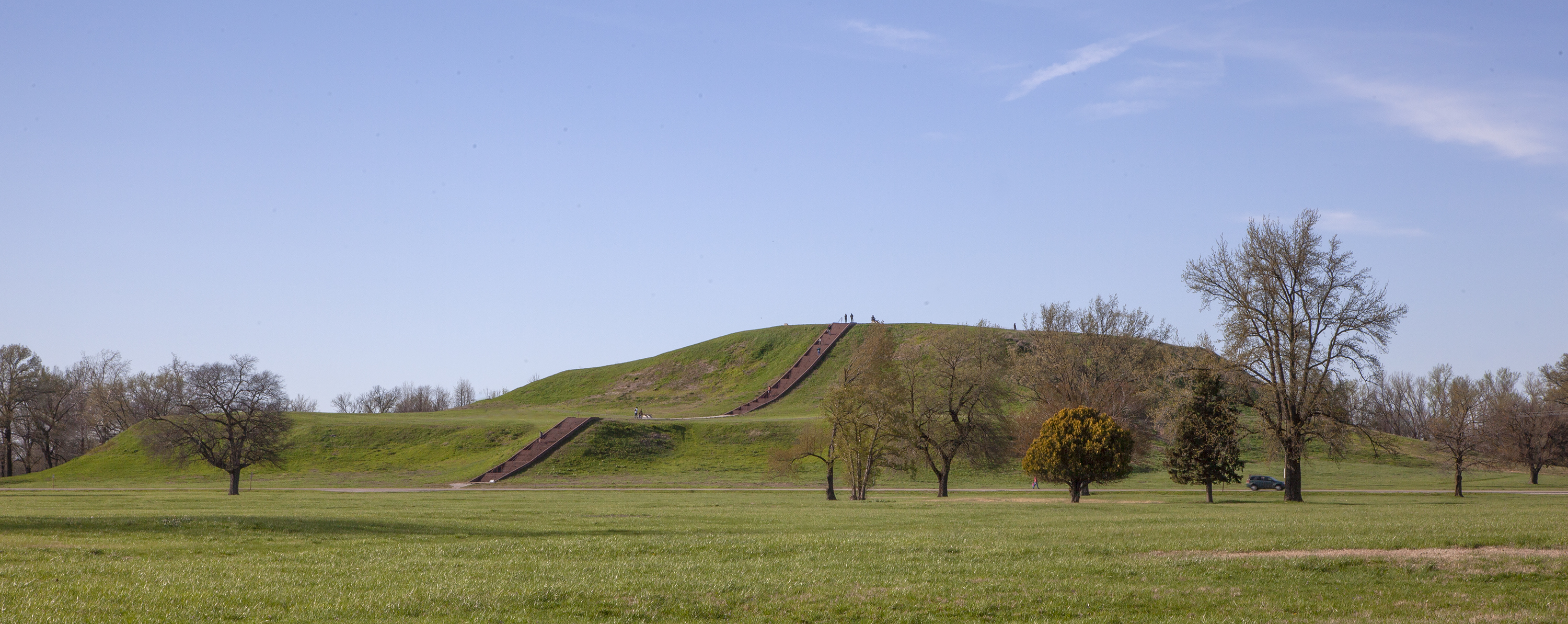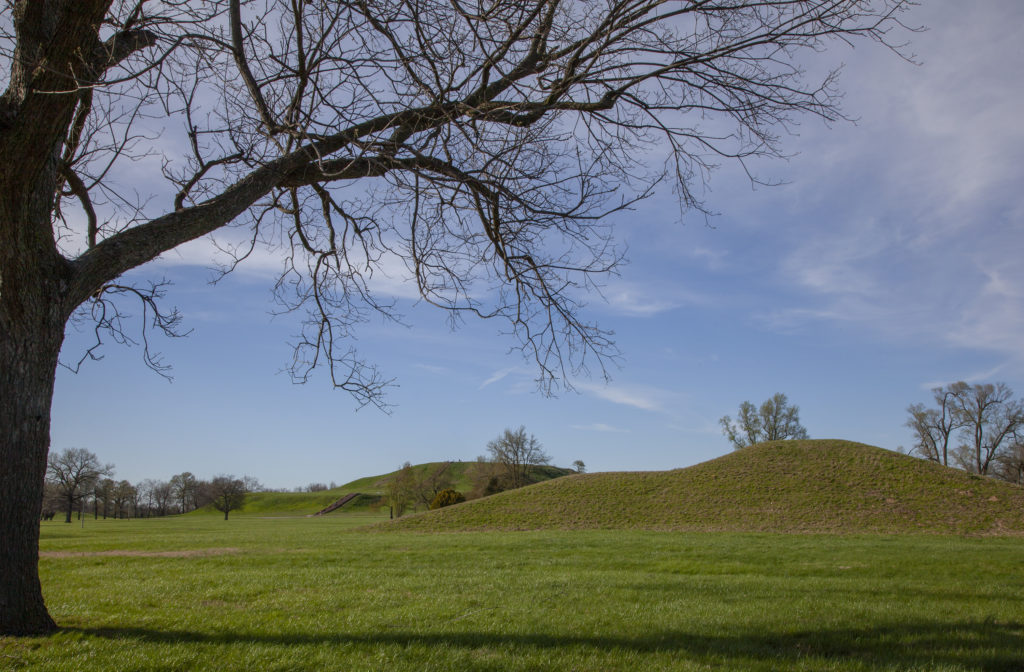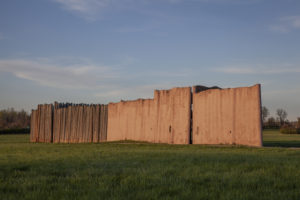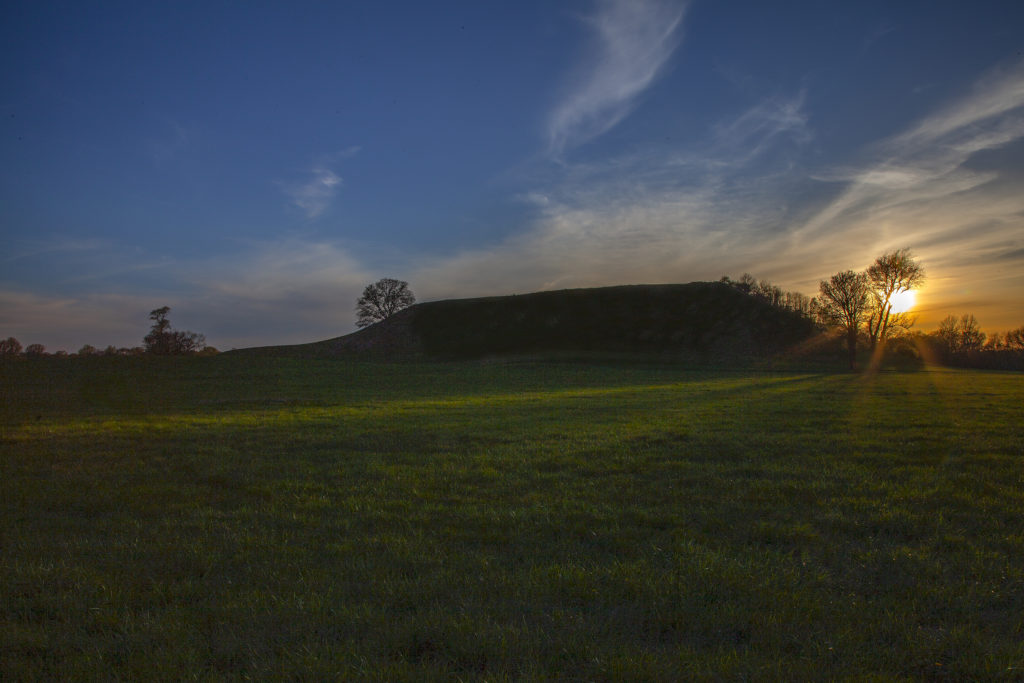
Monk’s Mound, the largest remaining mound at Cahokia Mounds State Historical Site. (Photo copyright 2019, Chris Madson, all rights reserved)
STRANGE HOW THE CURRENTS OF TIME EBB AND FLOW.
Not long ago, I found myself on the Mississippi River floodplain, just across from the bluffs of Jefferson Barracks, the historic army post on the southern edge of St. Louis. The plain on the Illinois side is not just flat; it’s almost perfectly level, like a rough-sawn board that’s been run through a planer. Twenty miles long, as much as nine miles wide, it lies at the confluence of the Mississippi and Missouri rivers, the work of thousands of years of flood water, dropping uncounted loads of silt.
I was staring up at a substantial hill on that horizontal expanse— a hill where no hill had any right to be— and I found that I shared the view of another traveler who had visited the place before me. In 1813, Henry Brackenridge, a judge in New Orleans, was so impressed that he took the time to write Thomas Jefferson about it:
“There are not less than one hundred mounds in two different groups,” he wrote; “one of the mounds falls little short of the Egyptian pyramid Mycerius. When I examined it in 1811, I was astonished that this stupendous monument of antiquity should have been unnoticed by any traveler: I afterwards published an account in the newspapers at St. Louis, detailing its dimensions, describing its form, position, etc., but this, which I thought might almost be considered a discovery, attracted no notice: and yet I stated it to be eight hundred paces in circumference (the exact size of the pyramid of Asychis) and one hundred feet in height.”[i]
Brackenridge’s mounds were the remains of a mighty city, but, as gigantic as they were, they seemed destined for anonymity. They were overlooked by explorers from Marquette to DeSoto and mostly forgotten, even by the descendants of the people who built them. Americans of Brackenridge’s time reacted to his report with a shrug, and over the next 150 years, generations of local residents mostly shared this indifference.
My fifth-grade teacher, a fanatic enthusiast of local history, arranged to bus our class down to the largest of the ancient monuments, known to locals as Monk’s Mound. As I recall, we walked up a dirt path to the top of what seemed to be a substantial hill on a remarkably flat plain at the edge of the town of Collinsville, Illinois, looked around, and went back to the bus for our peanut butter sandwiches.
By that time, a mound on the St. Louis side of the river, almost as large as Monk’s Mound, had been scooped up by steam shovels, loaded into wagons, and used for fill on a railroad line, while two mounds of similar size on the Illinois side had been flattened for farmland, and several others had been built over. It wasn’t until 1960, when the entire site was threatened by the construction of three interstate highways, that the combination of scientific interest and adequate funding allowed archaeologists to begin a serious analysis of the place.[ii]
It’s called Cahokia today. The real name is lost to memory— Cahokia is the name of a tribe that occupied the area until the 1820s.[iii] A thousand years ago, the residents of the rich bottomland suddenly began building cities. The remains of at least three are known today— the St. Louis complex, the East St. Louis complex, and the greater Cahokia complex. The Cahokia complex alone has more than 120 mounds. Monk’s Mound is the largest earthen structure in the New World, larger even than the stone Pyramid of the Sun in Teotihuacan or the Great Pyramid of Giza. The great ceremonial mound towers over a fifty-acre central plaza that was once surrounded by a wooden palisade twenty feet high. There was a circular astronomical observatory designed to track the motion of the sun across the heavens. Trade brought rare goods from as far away as the Gulf of Mexico, Lake Superior, and central Wisconsin.[iv] At its height, this city may have had 25,000 residents.[v]

Mound at Cahokia Mounds State Historical Site with Monk’s Mound in the background. (Photo copyright 2019, Chris Madson, all rights reserved)
After more than a century of increasing prosperity, Cahokia ran on hard times. There is no evidence of a sudden cataclysm, just a steady decline— by the fourteenth century, the city had been abandoned.[vi] Other, smaller population centers of the Mississipian culture survived and prospered to see the arrival of Spanish invaders and the subsequent plagues that decimated native populations, but by that time, Cahokia was not only gone, but forgotten by the descendants its builders had left behind.
Explanations for Cahokia’s decline vary. One of the leading experts on the site is convinced that it was the result of a steady decay of the social fabric that held the community together. He argues that the root cause may have been political— a loss of confidence in the ruling elite— or religious— a loss of faith. He finds evidence supporting his analysis in the harsher punishments, including decapitation, meted out to residents near the end of the city’s history.
Other Cahokia scholars offer a different explanation. The demands 20,000 people put on the local landscape must have been intense. One archaeologist has estimated that there were more than 600,000 wooden posts in the walls of the houses. More wood was required for beams and rafters. The palisade around the city center was built of something like 20,000 logs and demanded regular repair as the buried wood rotted. Then, there was the constant demand for firewood.

Re-creation of a small section of the palisade that once surrounded the plaza and major mounds at Cahokia Mounds State Historical Site. (Photo copyright 2019, Chris Madson, all rights reserved)
Some of the wood used at the site came from places as far away as the mouth of the Ohio River, 150 miles to the south, and as the city aged, the kinds of trees used in construction changed to less durable species like soft maple, hackberry, and willow. All this suggests that the timber around the city had been used up.
The loss of forests on the flood plain and nearby bluffs would have had the same effect they have today— increased runoff, erosion, flooding. At the same time, the diet of the populace was shifting from a protein-rich combination of fish and game as constant pressure decimated local wildlife populations, and crops like amaranth, goosefoot, and sunflower were replaced with a menu headed by corn.
A steady diet of corn isn’t good for people or the land that supports it. Even on a flood plain where topsoil is periodically replenished by high water, corn exhausts the soil, and it doesn’t provide humans with key nutrients. Analysis of teeth and bones from Cahokia suggests problems with infection and “nutritional stress.”[vii]
The two explanations for Cahokia’s decline aren’t mutually exclusive. It’s quite possible that the political and/or religious fabric of the community frayed over time. That’ll happen when the people are sick and hungry. The question remains: Which is cause and which is effect?
When I first heard the story of the rise and fall of Cahokia, I was struck with how familiar it sounded. Nearly sixty years ago, an agronomist and a conservationist got together to write a history of a different part of the world, the birthplace of western civilization in the Fertile Crescent of the Middle East and the shores of the Mediterranean. The book, Topsoil and Civilization, by Tom Dale and Vernon Gill Carter, is largely forgotten now, just as the ruins of Cahokia were forgotten, but it made a profound impression on me.
Dale and Carter had a view of the decline of the great nation-states that gave rise to modern Europe that diverged from the descriptions offered by generations of historians. While the “experts” focused on political and religious pressures as the forces that caused these societies to rise and fall, Dale and Carter favored a more basic explanation: soil. As they wrote at one point: “This has always been the way of historians and other writers— they usually write about the relations of human beings with each other and seldom about the relations of people to the land.”[viii]
The great cities along the Tigris and Euphrates were built on a foundation of grain produced in the irrigated fields on the river bottoms. As long as the fields produced, the cities prospered; when the fields grew sick from the salt left behind as the irrigation water evaporated, the cities withered. Famine, war, social dislocation followed. The ecological damage done lingers even today, nearly 3,000 years after it was inflicted.
The great city of Carthage suffered roughly the same fate, its fields of wheat eventually reduced to desert by the demands of the populace and the market. The famous cedars of Lebanon were removed from their mountain slopes for sale across the Mediterranean. The resulting erosion, combined with the browsing of growing herds of sheep and goats, kept the trees from growing back and finally stripped the land of any productive soil. Again, the damage done before the birth of Christ has yet to heal.
Greece? Dale and Carter saw the same pattern: “By the time of the Peloponnesian War most of the arable land of Greece was severely eroded and was producing only scant crops.”[ix]
And Rome? Dale and Carter considered the decline of farm productivity in the Roman Empire at great length, concluding with the story of Adria, a town established by the Etruscans on an island in the Adriatic Sea, then several miles from the mouth of the Po River. When the Romans annexed the river valley, local farmers were called upon to feed their masters to the south.
“By the end of the Western Roman Empire,” Dale and Carter wrote, “silt from the highlands had filled in the area so that Adria was no longer on an island, but was on the mainland.”[x] They concluded their chapter on the Romans with a short consideration of the efforts that are being made today to undo the damage that has been done: “The twentieth-century conservation work in Italy will undoubtedly help— but it is two thousand years too late to give the Italian people the resources they need to support a prosperous and dynamic civilization comparable to that of their famous ancestors.”[xi]
——-
There’s an epigram that has made the rounds for many years: “History doesn’t repeat itself, but it does rhyme.” The rhymes in these stories are chilling. The argument could be made that the declines of these civilizations

Monk’s Mound, the largest remaining mound at Cahokia Mounds State Historical Site. (Photo copyright 2019, Chris Madson, all rights reserved)
were ultimately the result of mismanagement, that our modern grasp of soil science, agricultural technique, timber management, ecological relationships, and wildlife conservation should keep us from supplying yet another rhyme in one of mankind’s oldest dirges.
But, with all our knowledge, we’re still losing nearly five tons of topsoil on every acre of cropland in America.[xii] Every year. And that doesn’t consider other impacts like soil compaction from heavy machinery or loss of microflora in the soil community to a variety of pesticides. A recent report from the World Wildlife Fund estimates that, overall, populations of vertebrate wildlife on earth have declined by sixty percent in the last fifty years. [xiii] We seem unwilling, or unable, to use what we know.
That’s no accident. In this, as in so many other areas of American life, our appetities and the profit margins of large corporations seem to overwhelm every other consideration. And beyond corporate greed, there’s another force at work— the insistent demand of a growing population. It’s the same pressure that has wrecked landscapes from Babylonia to Cahokia, and we seem no more capable of dealing with it now than the kings and chiefs in those far-off places dealt with it then. It may well be that we are prisoners of our own drive to breed.
As I watched the sun set over Cahokia that cool April evening, I saw, not only the ghosts of a sad and almost forgotten past, but the shades of a future that is uncertain at best. History may not repeat itself, I thought . . . but I can hear the rhyme.
[i] pp. 154-155. Brackenridge, H.M., 1818. On the populations and tumuli of the aborigines of North America. In a letter from H.M. Brackenridge, Esq., to Thomas Jefferson. Transactions of the American Philosophical Society 1: 151-159.
[ii] Young, Whiting Bloine and Melvin L. Fowler, 2000. Cahokia: The Great Native American Metropolis. University of Illinois Press, Urbana, Chicago, and Springfield, IL.
[iii] p.3. Young and Fowler, 2000.
[iv] P.387ff. Emerson, Thomas et al, 2018. Revealing Greater Cahokia, North America’s First Native City: Rediscovery and Large-Scale Excavations of the East St. Louis Precinct. University of Illinois at Urbana-Champaign.[v] p.310. Young and Fowler, 200
[vi] p.310. Young and Fowler, 2000.
[vii] p.233. Emerson, Thomas, et al, 2018.
[viii] p.90. Dale, Tom and Vernon Gill Carter, 1955. Topsoil and Civilization. University of Oklahoma Press, Norman, OK.
[ix] p.93. Dale and Carter, 1955.
[x] p.153, Dale and Carter, 1955.
[xi] p.155. Dale and Carter, 1955.
[xii] pp.5-49 and 5-67. USDA, 2018. Summary Report: National Resources Inventory. Natural Resources Conservation Service, Washington, D.C. and Center for Survey Statistics and Methodology, Iowa State University, Ames, IA.
[xiii] Grooten, Monique and Rosamunde Almond, 2018. Living Planet Report— 2018. Aiming Higher. World Wildlife Fund, Gland, Switzerland.
Leave a Reply
You must be logged in to post a comment.